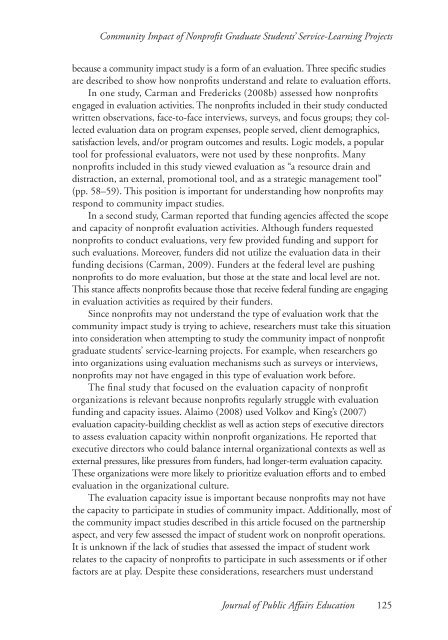Journal of Public Affairs Education
Create successful ePaper yourself
Turn your PDF publications into a flip-book with our unique Google optimized e-Paper software.
Community Impact <strong>of</strong> Nonpr<strong>of</strong>it Graduate Students’ Service-Learning Projects<br />
because a community impact study is a form <strong>of</strong> an evaluation. Three specific studies<br />
are described to show how nonpr<strong>of</strong>its understand and relate to evaluation efforts.<br />
In one study, Carman and Fredericks (2008b) assessed how nonpr<strong>of</strong>its<br />
engaged in evaluation activities. The nonpr<strong>of</strong>its included in their study conducted<br />
written observations, face-to-face interviews, surveys, and focus groups; they collected<br />
evaluation data on program expenses, people served, client demographics,<br />
satisfaction levels, and/or program outcomes and results. Logic models, a popular<br />
tool for pr<strong>of</strong>essional evaluators, were not used by these nonpr<strong>of</strong>its. Many<br />
nonpr<strong>of</strong>its included in this study viewed evaluation as “a resource drain and<br />
distraction, an external, promotional tool, and as a strategic management tool”<br />
(pp. 58–59). This position is important for understanding how nonpr<strong>of</strong>its may<br />
respond to community impact studies.<br />
In a second study, Carman reported that funding agencies affected the scope<br />
and capacity <strong>of</strong> nonpr<strong>of</strong>it evaluation activities. Although funders requested<br />
nonpr<strong>of</strong>its to conduct evaluations, very few provided funding and support for<br />
such evaluations. Moreover, funders did not utilize the evaluation data in their<br />
funding decisions (Carman, 2009). Funders at the federal level are pushing<br />
nonpr<strong>of</strong>its to do more evaluation, but those at the state and local level are not.<br />
This stance affects nonpr<strong>of</strong>its because those that receive federal funding are engaging<br />
in evaluation activities as required by their funders.<br />
Since nonpr<strong>of</strong>its may not understand the type <strong>of</strong> evaluation work that the<br />
community impact study is trying to achieve, researchers must take this situation<br />
into consideration when attempting to study the community impact <strong>of</strong> nonpr<strong>of</strong>it<br />
graduate students’ service-learning projects. For example, when researchers go<br />
into organizations using evaluation mechanisms such as surveys or interviews,<br />
nonpr<strong>of</strong>its may not have engaged in this type <strong>of</strong> evaluation work before.<br />
The final study that focused on the evaluation capacity <strong>of</strong> nonpr<strong>of</strong>it<br />
organizations is relevant because nonpr<strong>of</strong>its regularly struggle with evaluation<br />
funding and capacity issues. Alaimo (2008) used Volkov and King’s (2007)<br />
evaluation capacity-building checklist as well as action steps <strong>of</strong> executive directors<br />
to assess evaluation capacity within nonpr<strong>of</strong>it organizations. He reported that<br />
executive directors who could balance internal organizational contexts as well as<br />
external pressures, like pressures from funders, had longer-term evaluation capacity.<br />
These organizations were more likely to prioritize evaluation efforts and to embed<br />
evaluation in the organizational culture.<br />
The evaluation capacity issue is important because nonpr<strong>of</strong>its may not have<br />
the capacity to participate in studies <strong>of</strong> community impact. Additionally, most <strong>of</strong><br />
the community impact studies described in this article focused on the partnership<br />
aspect, and very few assessed the impact <strong>of</strong> student work on nonpr<strong>of</strong>it operations.<br />
It is unknown if the lack <strong>of</strong> studies that assessed the impact <strong>of</strong> student work<br />
relates to the capacity <strong>of</strong> nonpr<strong>of</strong>its to participate in such assessments or if other<br />
factors are at play. Despite these considerations, researchers must understand<br />
<strong>Journal</strong> <strong>of</strong> <strong>Public</strong> <strong>Affairs</strong> <strong>Education</strong> 125



